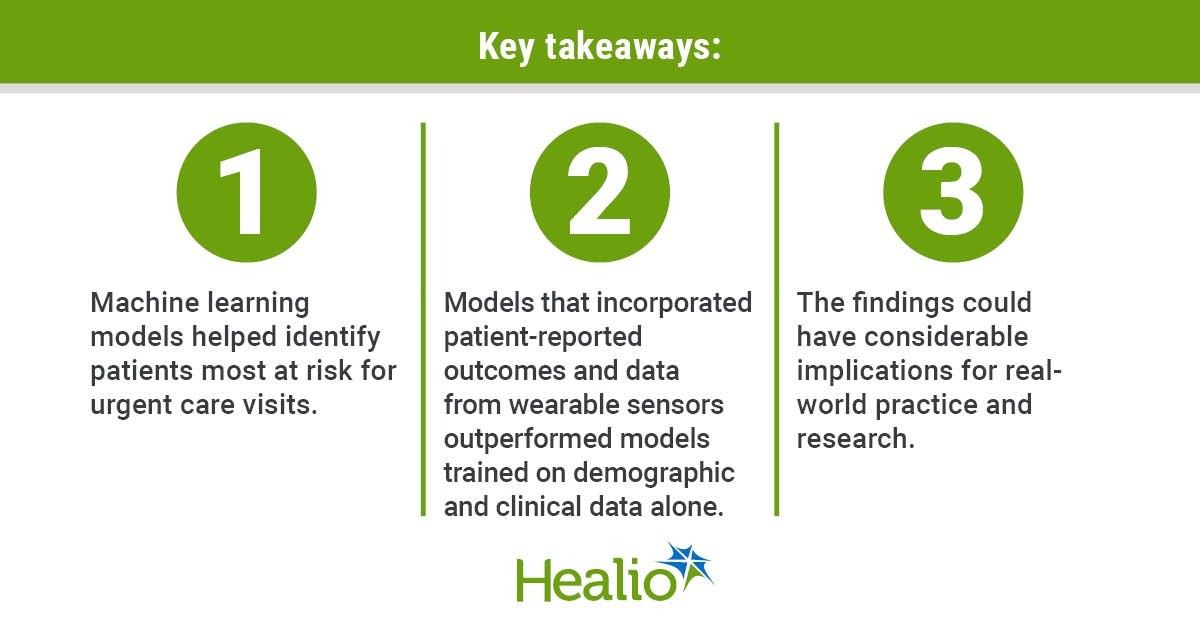September 22, 2025
5 min read
Key takeaways:
- Machine learning models can predict which patients receiving lung cancer therapy may need urgent care visits.
- The findings have potential applicability across oncology and beyond, researchers say.
Machine learning models can help predict which patients receiving systemic therapy for non-small lung cancer are most likely to need urgent care visits, according to study results.
Models that incorporated patient-reported outcomes and data from wearable sensors significantly outperformed models trained on demographic and clinical data alone.

Data derived from Gonzalez BD, et al. JCO Clin Cancer Inform. 2025;doi:10.1200/CCI-24-00315.
The findings could have considerable implications for real-world practice and research, investigators concluded.

Brian D. Gonzalez
“In the standard-of-care setting, algorithms that can predict risk for moderate or severe toxicities — and prevent them from getting bad enough to require a visit to an urgent care clinic or emergency department — could alleviate a considerable amount of pain, distress and life disruptions to patients while reducing costs to the health care system,” Brian D. Gonzalez, PhD, a researcher in Moffitt Cancer Center’s department of health outcomes and behavior, told Healio.
“The ability to do this with passive data collection and behind-the-scenes analysis could allow this to happen with minimal burden to patients or staff. In a clinical trial setting, if you can predict — and prevent — potential dose-limiting toxicities, that will increase the ability for trials to detect the true signal of the impact a drug has on clinical endpoints.”
Improving risk prediction
Patients with NSCLC frequently experience toxicities that require urgent care visits or other forms of unplanned health care use. In some cases, these toxicities necessitate treatment changes.
No well-established strategies exist to consistently identify patients most at risk.
Gonzalez and colleagues aimed to assess if patient-generated health data — including patient-reported outcomes and passively collected data from wearable sensors — could predict risk for urgent care visits among patients with NSCLC within 60 days of systemic therapy initiation.
“Sometimes there is disagreement between patients and providers about the severity of the toxicity but everyone agrees that if it’s bad enough to get you to an urgent care center, it’s something we’d like to anticipate,” Gonzalez said. “Patient-reported outcomes can help reduce risk for unplanned medical visits, but you’re not going to catch all of them unless you survey patients too often for this to be practical. The wearable sensors we used passively provide data every minute of every day.”
‘Highly sought after’ system
Researchers established a training set that included 58 patients (mean age, 69 years; range, 35-89; 57% women; 88% white) with NSCLC. More than two-thirds (69%) had adenocarcinoma, and a majority had stage III (48.2%) or stage IV (32.1%) disease.
All patients had been enrolled within 7 days of starting systemic therapy, defined as the pre-systemic therapy period.
Patients completed the PROMIS-57 questionnaire — which allows them to self-report various aspects of quality of life, well-being and pain intensity — at baseline and at 60-day follow-up. They also wore a Fitbit that captured patient-specific health data, including heart rate and sleep metrics.
Forty patients (69%) required at least one urgent care visit.
Researchers used Bayesian networks to develop four models to predict risk of urgent care visits, measuring predictive performance by area under the curve (AUC).
The first model used only pre-systemic therapy demographic and clinical data from medical records — including sex, age, BMI, cancer stage, adenocarcinoma status (yes or no), and albumin and calcium levels (AUC, 0.72; 95% CI, 0.57-0.8).
The second model used demographic information and clinical data obtained during systemic therapy. This incorporated changes in albumin and calcium from the pre-systemic therapy period to the time of urgent care visit, as well as receipt of chemotherapy, radiotherapy and/or targeted therapy (AUC, 0.81; 95% CI, 0.63-0.89).
The third model incorporated patient-reported outcomes data obtained during the pre-systemic therapy period, including PROMIS data related to anxiety and pain interference (AUC, 0.78; 95% CI, 0.66-0.88).
The fourth model incorporated clinical data obtained during systemic therapy, as well as data from wearable sensors (AUC, 0.86; 95% CI, 0.76-0.95).
DeLong tests that compared the two pre-systemic therapy models and during-systemic therapy models showed statistically significant outperformance with the addition of patient-reported outcomes and wearable sensor data (third model vs. first model, P = .002; fourth model vs. second model, P < .001).
Gonzalez said he was encouraged by the final model’s performance and the value of adding more on-treatment data.
There is “considerable provider buy-in” for what the researchers aimed to develop, he added.
For a future system based on the one tested in this study, “nobody on the clinical team has to call each patient every day to find out how they’re feeling, and it wouldn’t require additional visits for all patients,” Gonzalez said. “A low-burden system that alerts clinicians that a specific patient may be at risk for an unplanned medical visit and prompts them to check in with the patient would be highly sought after.”
Broad applicability
The proof-of-concept findings demonstrate the value of multidimensional data sources to improve machine learning models’ ability to predict health care utilization during early systemic therapy, Gonzalez and colleagues concluded.
Researchers acknowledged study limitations, including its single-center design and relatively small sample size. They also noted the measures analyzed in this study do not encompass all potential predictors of urgent care visits, and that other factors — including clinical or tumor-specific variables — could be missing from the models.
The next step is to explore whether these data can be used to predict additional clinical endpoints in the same patient population, and to refine and validate the approach in a larger cohort of patients with lung cancer, Gonzalez said.
There could be “broad applicability” of systems like this in oncology and other medical specialties, he added.
“In a post-surgery context, for example, a rise in temperature may indicate risk for infection,” Gonzalez said. “Unless we’re going to ask a patient to use a thermometer 10 or 20 times a day, a wearable sensor can provide a lot of data and predictive power that is not feasible any other way.”
Extensive validation is necessary, and high volumes of data must be collected to develop a fine-tuned algorithm unique to any setting where it may be used, Gonzalez added.
“An algorithm used for patients receiving systemic lung therapy will look different than an algorithm for patients receiving CAR T-cell therapy because they experience different toxicities,” he said. “Until we get to a point where there is large-scale collection of passive wearable-sensor data from, say, patients’ smartphones, there will need to be individual protocols. It will take time to replicate this in each unique setting.”
References:
For more information:
Brian D. Gonzalez, PhD, can be reached on X @BrianDGonzalez.










